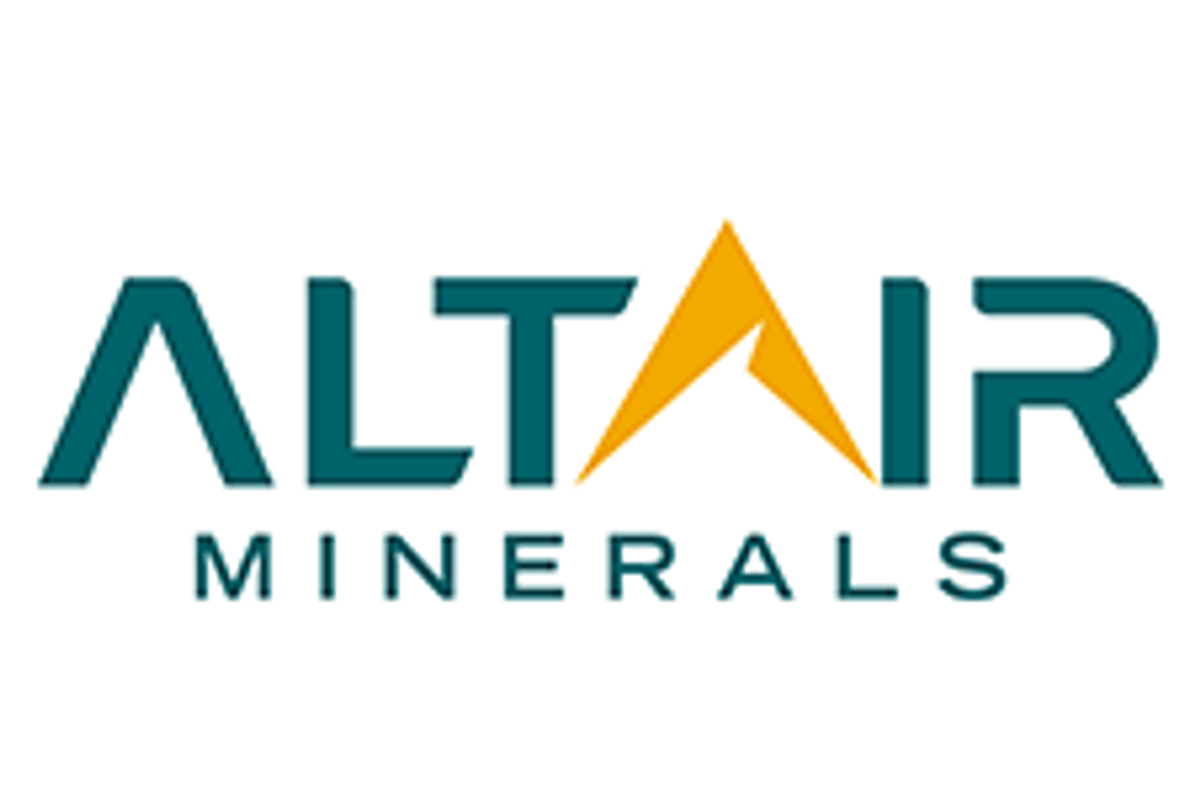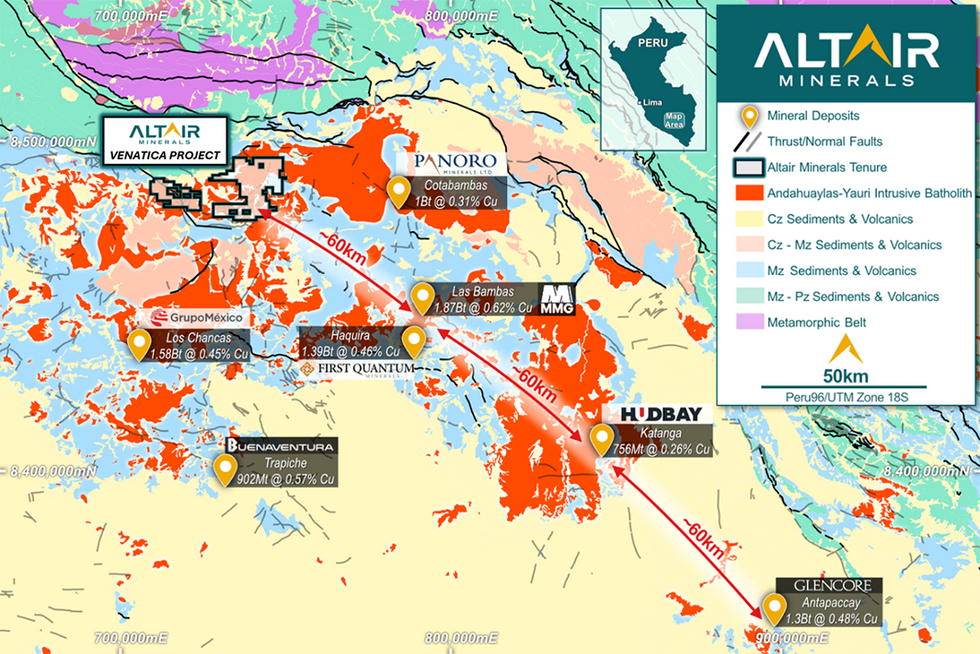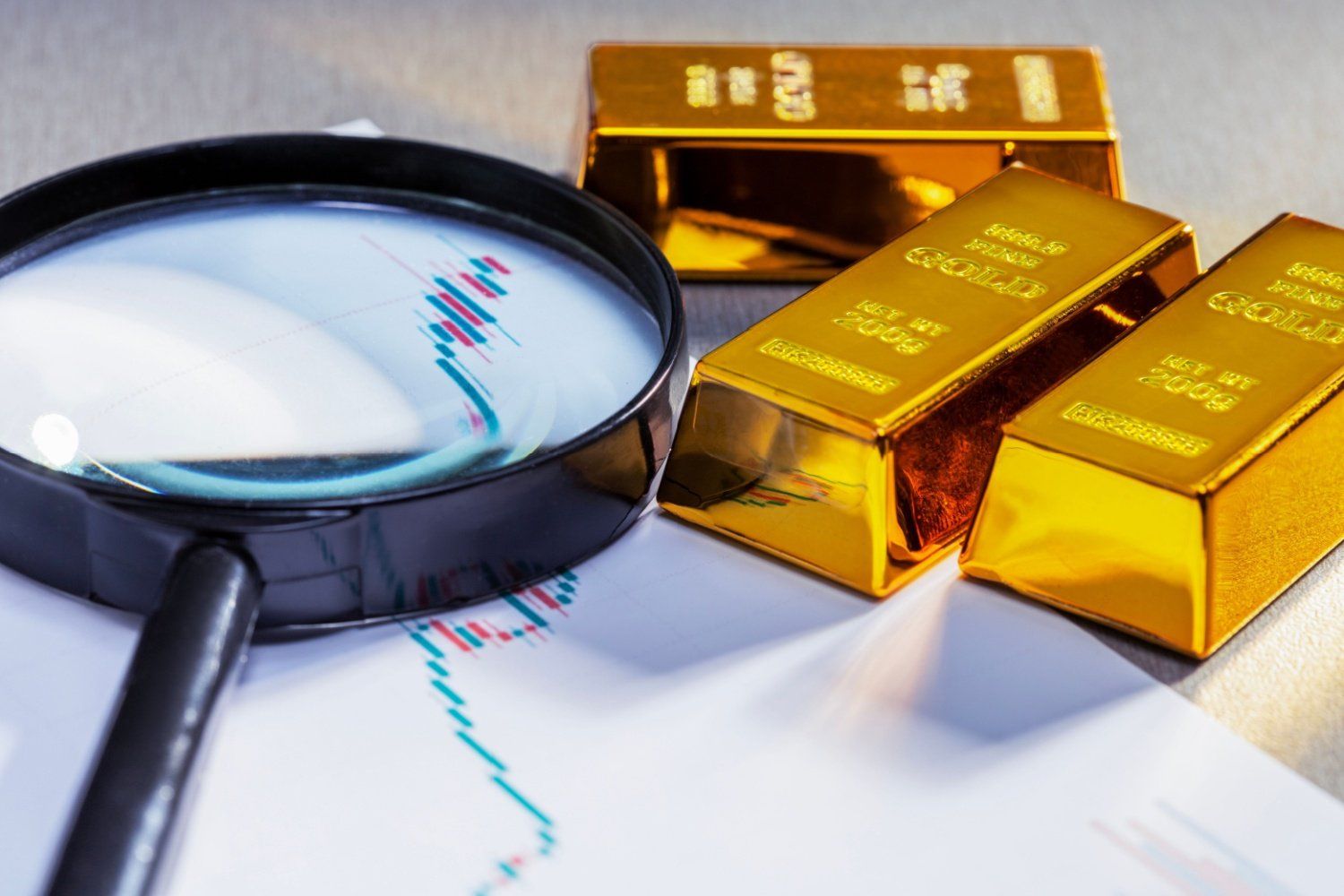
February 04, 2025
Strategically positioned to unlock the value of its Venatica and Olympic Domain projects, Altair Minerals (ASX:ALR) is leveraging cutting-edge exploration techniques and its seasoned technical team’s expertise for significant copper and gold discoveries. Through a disciplined and systematic approach, Altair centers on building a portfolio of high-quality assets with the potential to become Tier-1 discoveries.
Altair Minerals' flagship Venatica Project is strategically situated in Peru’s Andahuaylas-Yauri Porphyry Belt, a globally significant copper-producing region. The project is neighboring and sitting along strike Tier-1 mines, including Las Bambas, Antapaccay and Haquira, collectively establishing the area as one of the world’s premier porphyry copper districts.
 Location of Venatica Project, sitting along the Las Bambas trend and on key contact of Andahuaylas-Yauri Intrusive Batholith which is the main structural feature facilitating Tier-1 Copper deposits on the belt.
Location of Venatica Project, sitting along the Las Bambas trend and on key contact of Andahuaylas-Yauri Intrusive Batholith which is the main structural feature facilitating Tier-1 Copper deposits on the belt.Venatica’s land package is strategically positioned along the northern extension of the batholith intrusion contact zone, a geological anomaly known for hosting large-scale copper deposits with no modern exploration. Altair holds a first-mover advantage, being the first company to test the extension of this trend which has without failure made Tier-1 discoveries every ~60 km. The project’s geology is characterized by a combination of porphyry and skarn mineralization, which underpins its exceptional exploration potential.
Company Highlights
- Altair Minerals’ two world-class projects - Venatica in Peru and Olympic Domain in Australia - are located in globally significant mining districts, targeting Tier-1 copper and gold deposits.
- Venatica Project is a 337 sq km exploration project in the world-famous Andahuaylas-Yauri Porphyry Belt, featuring extensive copper-gold porphyry and skarn mineralization with proven high-grade historical production.
- The Olympic Domain project, located in South Australia’s Gawler Craton, is an 831 sq km IOCG project adjacent to BHP’s Oak Dam deposit (1.34 Bt @ 0.66 percent copper and 0.33 g/t gold) and boasts major analogous geophysical anomalies just 5 km from the Oak Dam deposit, indicative of significant mineralization.
- Historic sampling and exploration work was conducted at Venatica by INMET prior to its subsequent take over First Quantum for C$5.1 billion. The historic work has shown two major porphyry targets of 6 sq kmand 4 sq km, respectively, which have demonstrated abundant copper mineralisation at surface.
- Historic sampling at Venatica covers a small portion of the overall target, leaving substantial scope to expand its target size which remains open in all directions, these samples include:
- 7.0 percent copper and 33 g/t silver (sample 2254)
- 5.7 percent copper and 43 g/t silver (sample 4807)
- 4.8 percent copper and 32 g/t silver (sample 15245)
- 6.5 percent copper and 0.52 g/t gold (sample 4803)
- 4.8 percent copper and 0.40 g/t gold (sample 4801)
- Advanced geophysical techniques, modernized modelling has refined drill at Olympic Domain which shows previous impressive holes have narrowly missed the true core of the IOCG body, which shows a target size larger than the adjacent Oak Dam deposit owned by BHP.
- Altair’s boasts a first class and leading technical exploration team, who have cumulatively contributed to 11.4 Mt of copper and 26 Moz of gold discoveries in the past two decades.
This Altair Minerals profile is part of a paid investor education campaign.*
Click here to connect with Altair Minerals (ASX:ALR) to receive an Investor Presentation
ALR:AU
The Conversation (0)
10 September
Olympic Domain Project Update with BHP
Altair Minerals (ALR:AU) has announced Olympic Domain Project Update with BHPDownload the PDF here. Keep Reading...
09 September
World Class Exploration Team Formed & Fieldwork Imminent
Altair Minerals (ALR:AU) has announced World Class Exploration Team Formed & Fieldwork ImminentDownload the PDF here. Keep Reading...
03 September
Ex-Reunion Gold Team Joins & New Targets Defined
Altair Minerals (ALR:AU) has announced Ex-Reunion Gold Team Joins & New Targets DefinedDownload the PDF here. Keep Reading...
27 August
Olympic Domain Project Update with BHP
Altair Minerals (ALR:AU) has announced Olympic Domain Project Update with BHPDownload the PDF here. Keep Reading...
26 August
South Oko Geochemistry Confirms Oko West Look-Alike Target
Altair Minerals (ALR:AU) has announced South Oko Geochemistry Confirms Oko West Look-Alike TargetDownload the PDF here. Keep Reading...
26 December
Rick Rule, Ed Steer, Vince Lanci and More — Our Top 5 Interviews of the Year
2025 was a breakout year for gold and silver, and throughout its twists and turns the Investing News Network (INN) turned to experts for help navigating the markets.The INN team spoke with dozens of industry insiders over the course of the year, spending time with seasoned professionals who can... Keep Reading...
25 December
Jeffrey Christian: Gold, Silver at Record Prices, Expect Spikes Higher in 2026
Jeffrey Christian, managing partner at CPM Group, shares his outlook for gold and silver in 2026, explaining why he expects higher prices for the metals. "We think that 2026 is going to be a more hostile environment than 2025, and that will cause investors to buy more gold and silver. So we're... Keep Reading...
24 December
What Was the Highest Price for Gold?
Gold has long been considered a store of wealth, and the price of gold often makes its biggest gains during turbulent times as investors look for cover in this safe-haven asset.The 21st century has so far been heavily marked by episodes of economic and sociopolitical upheaval. Uncertainty has... Keep Reading...
24 December
Blackrock Silver Announces C$15 Million Strategic Investment by Two Cornerstone Purchasers
Blackrock Silver Corp. (TSXV: BRC,OTC:BKRRF) (OTCQX: BKRRF) (FSE: AHZ0) ("Blackrock" or the "Company") is pleased to announce a non-brokered private placement (the "Offering") of up to 13,636,363 units (the "Units") at a price of C$1.10 per Unit for gross proceeds of up to C$15,000,000. Each... Keep Reading...
24 December
Gold Price Hits New Record, Breaks US$4,500; Silver, Platinum Also at All-time Highs
Gold marked a new price milestone on Tuesday (December 23), continuing its record-breaking 2025 run. The spot price rose as high as US$4,511.83 per ounce, hitting that point at 4:04 p.m. PST. Don't forget to follow us @INN_Resource for real-time updates!Securities Disclosure: I, Charlotte... Keep Reading...
23 December
From Gold Coins to Copper Tools: Unique Festive Gifts for the Metals Investor
With pumpkin spice in the air, thoughts are turning to the biggest event of the year… No, not the curling championships — Black Friday and the start of the gifting season.Here at the Investing News Network, our team aims to provide relevant information to help readers make informed investment... Keep Reading...
Latest News
Interactive Chart
Latest Press Releases
Steadright Grants Stock Options
24 December
Silverco Confirms No Material Change
24 December
Related News
TOP STOCKS
American Battery4.030.24
Aion Therapeutic0.10-0.01
Cybin Corp2.140.00






